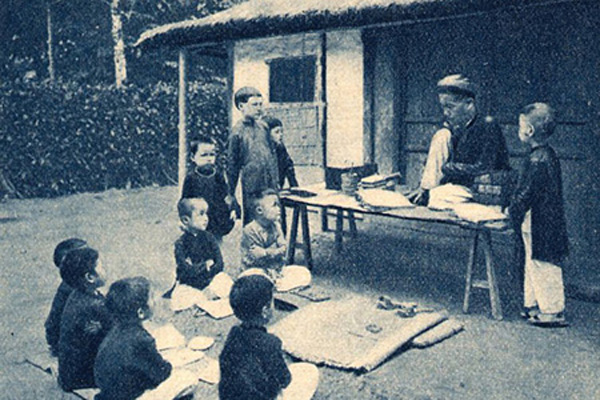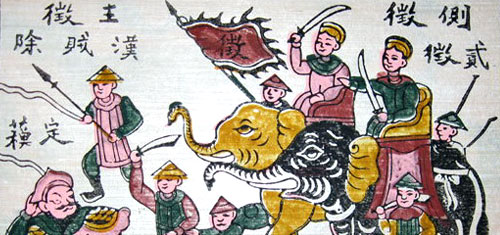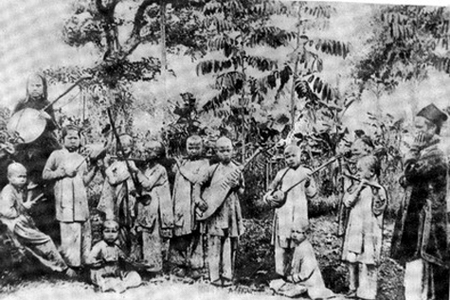The Chinese general Trieu Da (Chao To) annexed Au Lac, the country of the Viets in 179 B.C. But real Chinese political colonization only began after the conquest by the Han dynasty (111 B.C.)
Two facts characterize the Chinese occupation: the infiltration of the Han culture, and the continual revolts of the Vietnamese people.
The machinery of Chinese administration was run by bureaucrats appointed by the Chinese Court, which directly governed the country down to the provincial and district levels. A mandarin was seated in the principal town of the district, protected by fortified surrounding walls.
The imperial functionaries brought with them a clientele of subalterns, servants, soldiers, and relatives, some of whom in the end became vietnamized and stayed definitively in the country, integrating into the class of indigenous notables.
The population was bled white by numerous extortions and injustices. At the mercy of taxes and corves, the population was in addition forced to pay a large tribute to the parent state: ivory, sandalwood, and mother-of-pearl, as well as handicrafts like cloth, and work inlaid with gold, silver, or mother-of-pearl. The Annals record that people were forced to chase elephants and rhinoceroses in the forest, and to dive into the seas for pearls and coral.
The Chinese proconsuls implemented a policy of assimilation in order to integrate the “Viet province” more completely into the empire, the Cult of the Emperor, Son of Heaven, was instituted.

Chinese ideograms facilitated the entry of the official doctrine, Confucianism.
This doctrine wove a tight web of obligations and rituals that governed individual and social life, a web destined to replace the older ways of life of the Bronze Age.
Adventure tour Vietnam could be found here or more Vietnam classic tour here
Society was transformed little by little into feudalism. Patriarchy gradually replaced matriarchy.
Taoism, and especially Buddhism, penetrated along with Confucianism. Buddhism came in the second century B.C., both by land from China and by sea from India, although Vietnamese Buddhism is more closely related to Chinese Buddhism.
In the sixth century, Luy Lau (today a district of Ha Bac) became an important center of Buddhism in Southeast Asia, and daily life became imbued with Chinese manners and customs: marriage, mourning, festivals, and other rituals.
The occupiers introduced a form of economic exploitation that entailed new techniques and brought further growth. Intensive rice cultivation developed the use of iron ploughshares, hydrology, fertilizer, water buffaloes and oxen. The horse was introduced, and further developments made in the use of iron, in enameled pottery, in weaving and basket-making, and in paper and glass-making. There was progress in the navigation of rivers and seas, and trade increased with Java, Burma, and India, and along the Spice Route between China and Southeast Asia.
But the cruelty of the Chinese colonization had the effect of uniting the Vietnamese people in a permanent resistance, which exploded from time to time in armed insurrections. The sense of identity forged along the banks of the Red River during the Bronze Age was reinforced, and created a national awareness that favored the reconstitution of an independent state.
It is clear that, confronted by such a colossal enemy; these rebellions could only succeed when the parent country was weakened by internal dissension or menaces from the North. Although these insurrections were led by local chiefs and nobles, it was not unusual to find in their ranks descendants of Chinese functionaries, progeny of mixed marriages who had established themselves in Vietnam and thrown in their lot with the Vietnamese.

The first heroes of national resistance were women: the Trung sisters in the first century and Dame Trieu in the third century. Their memory haunts the popular imagination down to our day, and their annual festivals are celebrated with always-renewed enthusiasm. They are the Vietnamese equivalents of Joan of Arc.
The sixth century was marked by a major insurrection, led by Ly Bi and his lieutenants. At the beginning of the tenth century, Tang China fell into a long period of anarchy, and was forced to recognize a local Viet notable as Governor. After his death, power devolved to Ngo Quyen, who, in 938, defeated the Southern Han Chinese flotilla on the Bach Dang river. This victory ended more than ten centuries of Chinese domination.



